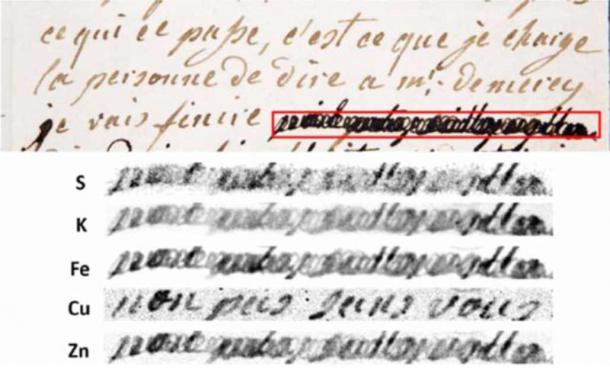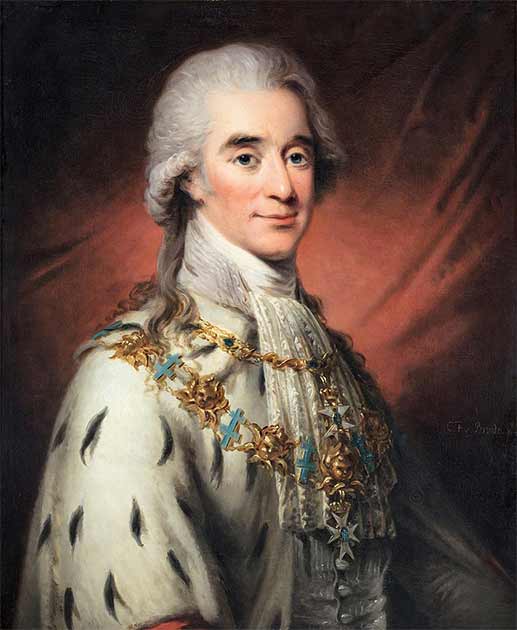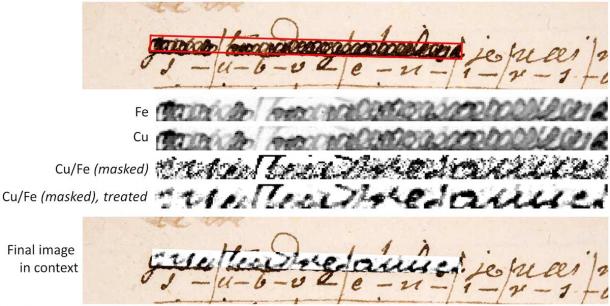A team of scientists has x-rayed Marie Antoinette’s letters to the Swedish count, Axel von Fersen, which were part of an affair as Marie was married at the time. Now, not only has a new way to unveil redacted content from ancient letters has been discovered, but rumors have been confirmed that the queen was cheating on her husband, the king of France no less!
The rumored “love letters” were exchanged between Marie Antoinette and the Swedish count, Axel von Fersen, during the French Revolution between 1791–92. An article in ArsTechnica explains that redacted sections of the letters have now been disclosed using a new x-ray scanning method. The identity of the unknown censor has puzzled historians for 150 years, but now, “X marks the spot!” according to Daily Mail , as a new x-rays of ink composition have allowed researchers to read the controversial redactions.

In this part of Marie Antoinette’s letter of 4 January 1792 to the count the copper elemental map revealed the original words “non pas sans vous.” (Anne Michelin / Science Advances )
The Forensics Behind Marie Antoinette’s Letter Censorship
Love. We’ve all dreamed about it, felt it and lost it. When most of us were children our parents were completely confused as to what love actually is. Innocently, they peddled us fairytale notions of an elusive magical force, knowing nothing of the high levels of dopamine and norepinephrine that are released during attraction to make us stay together long enough to procreate. These chemicals make us euphoric, energetic, creative and even giddy from time to time. But when it came to Marie Antoinette, well she was so “in love” it is a wonder she could eat or sleep. And chemicals have now revealed she was a cheating wife in love with another.
The team of researchers from Paris’s Centre de Recherche sur la Conservation (CRC) have published a new paper about some of Marie Antoinette’s letters in the journal Science Advances . They scanned a collection of secret love letters that were exchanged between Marie Antoinette and Swedish Count Axel von Fersen and distinguished the different types of inks used in the original text, and in the redactions. The words “beloved,” “madly” and “adore” emerged from the scans, which stand testimony to how smitten the lovers had become. However, many of the letters were found to be copies.

Swedish Count Axel Fersen in a portrait by Carl Frederik von Breda. (Carl Frederik von Breda / Public domain )
Tracking Down The Anonymous Love Censor
The new x-ray method used to make these discoveries is called fluorescence spectroscopy micro scanning. This non-destructive analysis technique peers deep into chemical structures, and team leader, chemist Anne Michelin, told CNN that they applied the technique to 15 redacted sections of the collection of 8 historical letters. By charting the ratios of chemical variations in the inks, between “copper-to-iron and zinc-to-iron,” the researchers revealed the original underlying text.
Bringing light to the most complicated sections of these 8 sections of redacted text, the researchers applied “multivariate statistical analyses.” This subdivision of statistics represents the observation and analysis of more than one outcome variable. In this case, the method analyzed the two different inks, distinguishing how they related to each other.
It turned out that the same inks were used to write some of the supposed letters “from” Marie, and that same ink was used to make many of the redactions. Thus, many of the love letters were copies that the count had made himself, revealing he was the anonymous person who had censored the content with redactions from the original letters from Marie Antoinette. But why would the count do such an apparently bizarre thing as to rewrite love letters from a queen?

In this letter from the count to Marie Antoinette on 13 October 1791 two methods were combined to reveal the text “ma tendre amie.” (Anne Michelin / Science Advances )
A Count Protecting The Integrity Of A Cheating Queen
The researchers concluded that even though they know Count Fersen was the censor of the letters, the question remains outstanding as to whether the copies with the redactions were made for sentimental reasons or if this was all part of a greater political strategy . The team speculates in their paper that maybe the count wanted to “protect the honor” of the cheating queen. But they also consider that the count was maybe also protecting his own interests. Like, perhaps he knew his head would have been on a chopping-block if the affair had been made public.
We really should, however, wrap this up with Marie Antoinette . While everyone associates her with ostentatious fashion, and decapitation, this new way to analyze old letters has revealed that behind the charade, Antoinette was a cheat, unhappy in marriage , and lying to her husband and indeed an entire nation. Sometimes, not even the world is enough to satisfy a love hormone saturated heart.
Top image: In this painting by Joseph Kranzinger Marie Antoinette is 16 years old. It was only later that the Marie Antoinette letters of love were written to the count, when she was unhappy in her marriage. Source: Joseph Kranzinger / Public domain
By Ashley Cowie
 RSS Feed
RSS Feed















 October 6th, 2021
October 6th, 2021  Awake Goy
Awake Goy  Posted in
Posted in  Tags:
Tags: 













